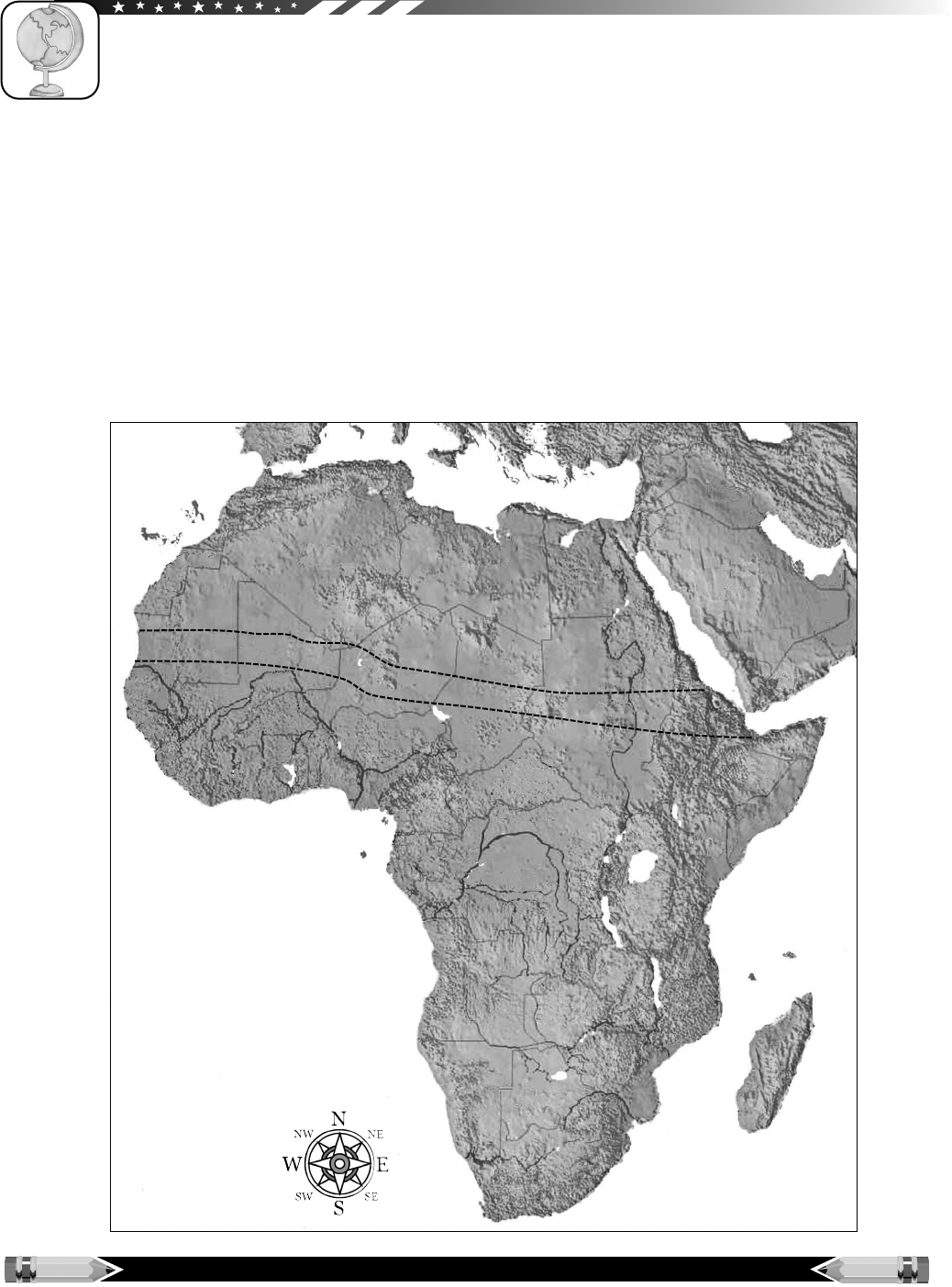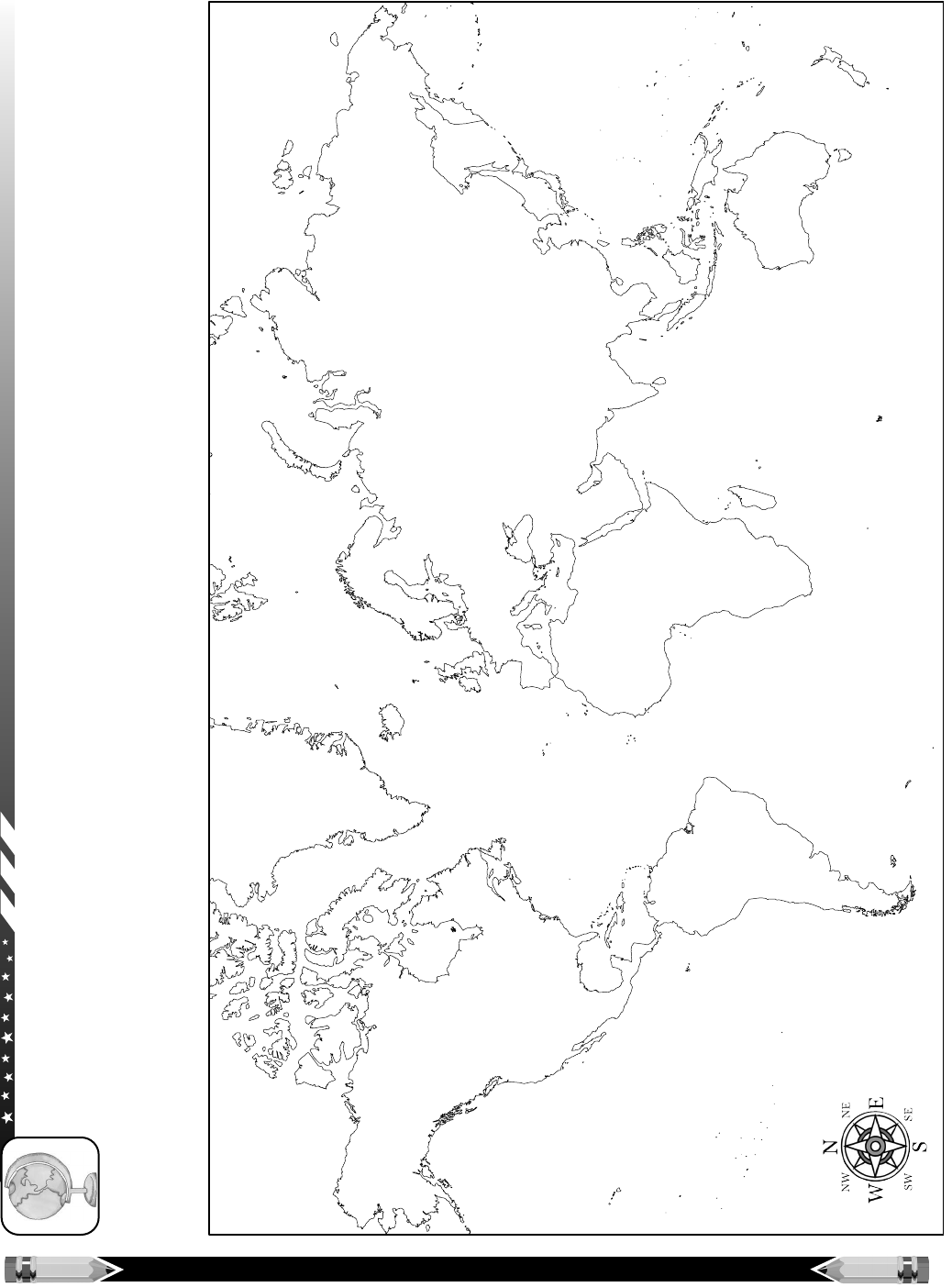
©Carole Marsh/Gallopade International • www.gallopade.com • Page 7
~ This book is not reproducible. ~
SSeeccttiioonn 11
AFRICA

Chapter 1
Physical Features of Africa
The vast continent of Africa has a variety of landforms. Keep reading to learn about some of the
physical features that make Africa such an interesting place!
• The Sahara is the world’s largest hot desert, covering most of Northern Africa. It
stretches from the Red Sea to the outskirts of the Atlantic Ocean. In the south, it
stretches to the Sahel.
• The Sahel is the transition zone south of the Sahara and north of the equator that separates the Sahara
from tropical rain forests. It has become more of a desert in recent years. Djenne and Timbuktu are
part of the Sahel.
• The savanna is the picture of Africa you see in the movies, with rolling grassland and
scattered trees and shrubs. The most famous savanna is the Serengeti, straddling the
borders of Kenya and Tanzania. There are 4.5 million square miles of savannas in Africa.
• The central African tropical rainforest in the Democratic Republic of the Congo is the
second largest rainforest in the world. About 90 percent of the African
rainforests have been deforested because of logging, road building, and poor farming.
• Flowing through west central Africa, the Congo River is the second longest river in Africa,
and the fifth longest river in the world. It crosses the equator twice and is surrounded by
rain forest.
©Carole Marsh/Gallopade International • www.gallopade.com • Page 8
~ This book is not reproducible. ~
Geographical
Understandings
SS7G1 The student will locate selected features of Africa.
a. Locate on a world and regional political-physical map: the Sahara, Sahel, savanna, tropical
rainforest, Congo River, Niger River, Nile River, , Lake Tanganyika, Lake Victoria, Atlas Mountains,
and Kalahari Desert.
b. Locate on a world and regional political-physical map the countries of Democratic Republic of
the Congo (Zaire), Egypt, Kenya, Nigeria, South Africa, Sudan, and South Sudan.

• The Nile River is the world's longest river (4150 miles). It flows northward out
of the mountains of central Africa through eastern Africa into the
Mediterranean Sea.
• The Niger River is the principal river of western Africa. It flows into the
Atlantic Ocean. Five west African nations depend on it for their water.
•The Atlas Mountains are a range in northern Africa between the Mediterranean Sea and the Sahara
Desert. They are located in Morocco, Northern Algeria and Tunisia.
•The Kalahari Desert is a large, arid to semi-arid sandy area in southern
Africa covering much of Botswana and parts of Namibia and South
Africa. Its dunes range from 20 to 200 feet high and can be 50 miles long.
• Lake Tanganyika is the longest lake as well as the second-deepest lake in the world. It lies in central
Africa between Tanzania and Congo in the Great Rift Valley.
• Lake Victoria is a headwaters reservoir for the Nile River and the largest lake in Africa. It’s the second
largest freshwater lake in the world and is quite shallow. Kenya, Tanzania and Uganda border it.
Map Skills
Study the map of
African
landforms and
answer the questions.
1. What is the major landform
of northern Africa?
2. What landform covers most
of central and southern Africa?
3. What landform lies along the
Atlantic coast near the equator?
4. Use the map scale to
determine about how many
miles the Kalahari Desert covers
from north to south.
5. Use the map scale to measure
the length of Lake Tanganyika.
©Carole Marsh/Gallopade International • www.gallopade.com • Page 9
~ This book is not reproducible. ~
African Landforms

Map Skills
Look at the map of Africa with the major physical features identified. Follow the directions below.
1. Draw a brown box around the Sahara Desert and make brown dots for sand.
2. Draw an orange box around the Sahel.
3. Draw a green box around the savanna.
4. Draw both green and red boxes around the tropical rainforest.
5. Trace the Congo River in blue.
6. Trace the Nile River in blue.
7. Trace the Niger River in blue.
8. Draw purple peaks for the Atlas Mountains.
9. Draw a brown box around the Kalahari Desert and make brown dots for sand.
10. Color Lake Tanganyika blue.
11. Color Lake Victoria blue.
©Carole Marsh/Gallopade International • www.gallopade.com • Page 10
~ This book is not reproducible. ~
Sahara
Desert
Sahel
Niger River
Niger River
Nile River
C
o
ng
o
Ri
ve
r
Lake Victoria
Lake Tanganyika
Kalahari
Desert
Atlas Mountains
savanna
savanna
savanna
savanna
tropical
rainforest
rainforest
savanna
tropical
rainforest

©Carole Marsh/Gallopade International • www.gallopade.com • Page 11
~ This book is not reproducible. ~
Map Skills
Draw and label the following physical features on the map of Africa below.
Sahara Desert Sahel savanna tropical rainforest
Congo River Nile River Niger River Atlas Mountains
Kalahari Desert Lake Tanganyika Lake Victoria

©Carole Marsh/Gallopade International • www.gallopade.com • Page 12
~ This book is not reproducible. ~
Map Skills
Draw and label the following physical features on the world map below.
Sahara Desert Savanna Sahel Tropical rainforest
Congo River Nile River Niger River Atlas Mountains
Kalahari Desert Lake Tanganyika Lake Victoria

©Carole Marsh/Gallopade International • www.gallopade.com • Page 13
~ This book is not reproducible. ~
Map Skills
Look at the political map of Africa with the countries identified. Follow the directions below.
1. Draw a red circle around South Africa.
2. Draw a purple box around Sudan.
3. Draw a black box around Egypt.
4. Draw a green circle around Kenya.
5. Draw a brown box around Nigeria.
6. Draw a blue circle around the Democratic Republic of the Congo (Zaire).
KENYA
KENYA
ETHIOPIA
ETHIOPIA
ERITREA
ERITREA
SUDAN
SUDAN
EGYPT
EGYPT
NIGER
NIGER
MAURITANIA
MAURITANIA
MALI
MALI
NIGERIA
NIGERIA
SOMALIA
SOMALIA
NAMIBIA
NAMIBIA
LIBYA
LIBYA
CHAD
CHAD
SOUTH AFRICA
SOUTH AFRICA
TANZANIA
TANZANIA
ANGOLA
ANGOLA
ALGERIA
ALGERIA
MADAGASCAR
MADAGASCAR
MOZAMBIQUE
MOZAMBIQUE
BOTSWANA
BOTSWANA
ZAMBIA
ZAMBIA
GABON
GABON
CENTRAL
CENTRAL
AFRICAN REPUBLIC
AFRICAN REPUBLIC
TUNISIA
TUNISIA
MOROCCO
MOROCCO
UGANDA
UGANDA
SWAZILAND
SWAZILAND
LESOTHO
LESOTHO
MALAWI
MALAWI
BURUNDI
BURUNDI
RWANDA
RWANDA
TOGO
TOGO
BENIN
BENIN
GHANA
GHANA
IVORY
IVORY
COAST
COAST
LIBERIA
LIBERIA
SIERRA LEONE
SIERRA LEONE
GUINEA
GUINEA
BURKINA
BURKINA
GAMBIA
GAMBIA
CAMEROON
CAMEROON
ZIMBABWE
ZIMBABWE
CONGO
CONGO
DEM.REP.
DEM.REP.
OF CONGO
OF CONGO
EQUATORIAL GUINEA
EQUATORIAL GUINEA
WESTERN
WESTERN
SAHARA
SAHARA
DJIBOUTI
DJIBOUTI
SENEGAL
SENEGAL
GUINEA
GUINEA
BISSAU
BISSAU
SOUTH
SOUTH
SUDAN
SUDAN
ATLANTIC
OCEAN
INDIAN
OCEAN

©Carole Marsh/Gallopade International • www.gallopade.com • Page 14
~ This book is not reproducible. ~
Map Skills
Label the following countries on the map of Africa below:
South Africa Sudan Egypt Democratic Republic of the Congo (Zaire)
Kenya Nigeria South Sudan

©Carole Marsh/Gallopade International • www.gallopade.com • Page 15
~ This book is not reproducible. ~
Map Skills
Label the following countries on the world map below.
Egypt Nigeria Sudan South Sudan Kenya South Africa Democratic Republic of the Congo

©Carole Marsh/Gallopade International • www.gallopade.com • Page 16
~ This book is not reproducible. ~
Quick Review
Now see how much you’ve learned about African geography. Write the letter for the correct answer on
the line beside the question.
1. What is the southernmost country in Africa?
A. Botswana B. South Africa C. Rwanda
2. What is the world’s largest hot desert?
A. Kalahari B. Sahara C. Mohave
3. What African lake is the longest and second-deepest in the world?
A. Lake Victoria B. Lake Chad C. Lake Tanganyika
4. The world’s longest river is:
A. Niger River B. Nile River C. Congo River
Chapter 2
Polluted Water—Unfit to Drink
Pesticides, fertilizers, human waste, storm water runoff,
mining, and manufacturing byproducts all contribute to
water pollution in Africa. Fully half of the patients in
hospital beds are there because of unclean drinking water,
impacting the economy by reducing the workforce. In rural
areas, an estimated one million children die each year from
contaminated water. Many humanitarian organizations
provide clean water and help rebuild the infrastructure to
maintain a clean water supply. However, as the population grows in some countries, the amount of
clean water is actually decreasing.
Polluted water directly harms the fishing industry by either killing the fish or making them unfit to
eat. On average, there are two oil spills a day in Nigeria. This affects trade by ruining the land for
SS7G2 The student will discuss environmental issues across the continent of
Africa.
a. Explain how water pollution and the unequal distribution of water impact irrigation, trade,
industry, and drinking water.
b. Explain the relationship between poor soil and deforestation in Sub-Saharan Africa.
c. Explain the impact of desertification on the environment of Africa from the Sahel to the
rainforest.
Word Definition
infrastructure: the basic
physical systems of a
country's population, including
healthcare, roads, utilities, water, and
sewage
landlocked: enclosed, or nearly
enclosed by land
